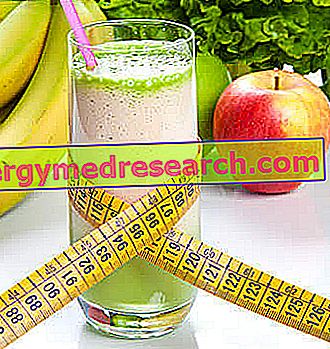Centrifuged: what are they?
Centrifuges are food beverages with specific nutritional properties. They are obtained by separating the liquid fraction from the fibrous leaf and stem fruit and vegetable root. Note : there are plants that do NOT lend themselves to producing centrifuged; in particular it is better to avoid aubergines, rich in solanine; potatoes and fresh legumes are also not very pleasant (poor in water, rich in waste, containing indigestible molecules and a questionable taste).

Centrifuges can contain one or more main ingredients; moreover they are often added also:
- Additional amounts of water
- Aromatic herbs and / or spices
- Natural or synthetic sweeteners, calories or acoric
- Vegetable oils cold pressed
- Essential oils
- Peanut butter
- Yogurt or milk
- Propolis
- Food supplements (proteins, amino acids, etc.) etc.
The centrifugates are obtained by centrifugation, then using an electrical appliance called a centrifuge. The juices and extracts are similar to centrifuges. On the contrary, shakes are basically different, as they do not contain the fibrous residue and contain the ingredients in their entirety.
Nowadays centrifugates are considered real nutraceutical, dietetic, curative and slimming foods. Because of their richness in vitamins, mineral salts, polyphenolic antioxidants and water, and their low caloric intake, they are considered the healthy drinks par excellence. However, this reputation is only partly acceptable; in the next few paragraphs we will better understand why.
Centrifuge online

Online a fruit and vegetable juicer is available with a powerful 800 watt motor (made silent thanks to the use of stainless steel baskets that contribute to reducing the decibel emission) that allows you to adjust the speed depending on the food to be centrifuged.
Thanks to its very wide mouth (about 75 mm), this product is able to centrifuge and squeeze fruit and vegetables of any size, even the largest ones, without the need to slice them or cut them into small pieces.
In addition to the modern design and small size, this centrifuge also has a container for collecting very large juice (over a liter) and the possibility of easily disassembling all the pieces that come into contact with food, so as to make it quick and practice the cleaning operation.

Alternatively, you can opt for a centrifuge with a professional motor, suitable for intensive, silent and air-cooled use. The product has two selectable speeds: speed 1 for soft foods and speed 2 for hard foods.
The wide mouth facilitates the insertion of medium-sized pieces, while the comfortable pestle allows the pressure of the ingredients to be centrifuged. The juice container is then equipped with a foam separator. All parts in contact with food are BPA-free (without bisphenol A).
Even the cleaning of the appliance is very easy: just a pass under the tap and the sieve and the stainless steel blades are immediately clean. The cleaning brush is supplied with the centrifuge.
Lose weight: How?
Do centrifugates make you lose weight?
It depends. Centrifuges, like all foods, must be placed in a special nutritional context. Unfortunately, the reputation of "slimming drinks" arises in an incorrect or at least equivocal manner, given that many people use centrifuges as "substitute meals". This is applied, at best, replacing a snack or breakfast and, at worst, replacing lunch and / or dinner.
Needless to say, while reducing caloric intake and promoting weight loss, using centrifuged in this way can become a habit that is anything but healthy. In order to stay healthy even during weight loss, the body needs:
- All essential molecules: amino acids, fatty acids, water-soluble vitamins, fat-soluble vitamins and minerals
- Nutritional balance of energy macronutrients: carbohydrates (about 55% of total calories), lipids (25-30%) and proteins (from 13% to 18%, depending on the bibliographic source)
- An essential caloric intake to support biological functions: generally not less than 70% of the normal one.
Centrifuged to lose weight: positive and negative implications
By using centrifuges as a replacement meal, all three of these basic requirements could be eliminated. Let's see why:
| Example Normocalorica Diet | Energy distribution of meals | Carrot apple centrifuge | ||
Meal | Kcal percentage | Quantity kcal | 200 ml = 85 kcal | |
Total 1800 kcal | Breakfast | 15% kcal | 270 kcal | 85 - 270 = - 185 kcal |
Snack | 5% kcal | 90 kcal | 85 - 90 = - 5 kcal | |
Lunch | 40% kcal | 720 kcal | 85 - 720 = - 635 kcal | |
Snack | 5% kcal | 90 kcal | 85 - 80 = - 5 kcal | |
Dinner | 35% kcal | 630 kcal | 85 - 630 = - 545 kcal | |
Centrifuged to lose weight instead of snacks
As can be appreciated from the table above, using the centrifuged to replace a meal of the day may or may not be appropriate depending on the case. By replacing secondary snacks, which represent about 5% of energy, the effect is good. A significant slimming result is not achieved, but the overall nutritional balance remains more or less the same, with the disadvantage of not introducing fruit and vegetable fibers.
In certain high-calorie diets, where the fiber tends to be in excess (eg diet of the triathlete or competitive athletes), this could also be considered an advantage. The same applies to the diet of people who suffer from irritable bowel syndrome with diarrhea, in which by means of centrifuged water, minerals and vitamins can be introduced without increasing the insoluble fibers (potentially responsible for the worsening of diarrhea - see also: Low Residue Diet). Furthermore, in the diet of people who do NOT eat sufficient amounts of fruit and vegetables (for example children), centrifuged can help increase the intake of vitamins (especially A and C), mineral salts (especially potassium and magnesium), water and antioxidant polyphenols. Be careful, however, the centrifuges are not equivalent to the VI and VII group of foods because, as we have already pointed out, they are free of dietary fiber.

Centrifuged to lose weight instead of breakfast
In the case of breakfast, the caloric gap begins to be significant, around 10% of total calories. This would guarantee a weight loss of about 1 kg per month. It would be an altogether acceptable parameter, except that breakfast is generally delegated to:
- Introduce the calories needed to start the body and support it until lunch (from cereals or derivatives)
- Improve the intake of calcium, phosphorus and riboflavin (vit B2) contained in milk.
Assuming that a person is able to withstand the stimulus of hunger, it is still necessary to correct the other 4 meals in the diet, which will have to be more abundant than yogurt and cheese to fill the deficit of vitamin B2, calcium and phosphorus.
Centrifuged to lose weight in place of lunch or dinner
Finally we come to the less advisable use of centrifuged: the replacement of lunch or dinner. This nutritional correction would result in a deficit of around 30% of the daily energy. In itself, it would seem a positive variation, as it would lead to a weight loss of about 3 kg in a month. However, this calorie reduction is concentrated in a single meal, which would inevitably lead to:
- Hunger is difficult to control, between lunch and dinner or between dinner and breakfast
- Reduction of global energies
- Consequent "rebound effect" on the caloric intake; too much hunger would cause an increase in the dietary intake of other meals, negating the global strategy.
Furthermore, depending on the meal replaced, the following may be compromised:
- High biological value proteins
- Vitamins and minerals from meat, fish and eggs
- Eicosapentaenoic acid and docosahexaenoic acid; the two most active metabolites of the omega 3 essential fatty acid
- Complex carbohydrates.
Note : if the centrifuges were to replace both lunch and dinner, the energy depletion would exceed 60% of the total calories, putting at risk the state of health of the individual also in the medium and short term.
Centrifuged for weight loss and oxidative stress
The biggest advantage of using centrifuged for weight loss is that, while all foods are reduced in the common diet, inexorably even fruit and vegetables, using centrifuges you are guaranteed to continue to supply the right amounts of specific nutrients. In particular, these drinks promote defenses against free radicals and can improve the metabolic condition. It is a uniquely positive aspect that, moreover, assumes greater importance in the context of food therapies aimed at treating metabolic pathologies such as: hypercholesterolemia, hypertriglyceridemia, type 2 diabetes mellitus, arterial hypertension and metabolic syndrome in general. Moreover, using an antioxidant power, the centrifugates support the body's defenses against tumors and cellular aging.
Centrifuged for weight loss and anti-nutrients
The centrifuged, being made from raw fruits and vegetables, also contain several anti-nutrients. Most of it is trapped in the fibrous waste, even though the fraction that remains in the liquid can still hinder nutritional absorption. Among the various, oxalates, phytates and tannins are generally more abundant, which significantly limit the uptake of certain minerals. Also for this reason, better to avoid exaggerating with the centrifuged in the diet.
Waste
How to use centrifuge waste?
The centrifuged waste is mainly composed of the pulp, that is, of a fibrous residue. By itself, this component has a precise nutritional role (prebiotic, useful for intestinal motility, favorable for modulating absorption, etc.) and should not be discarded. However, being an "inevitable" effect, it becomes useful (or necessary) to find a way to reuse this gap.
For the fanatics of home cultivation, the pulp of the centrifuges ends up directly in the compost bin. Others, however, prefer to eat it, but do not always find a suitable solution. To make these waste palates pleasant, they can be used as follows:
- Ingredients for the broth: this is especially true for vegetable residues
- Ingredients for vegetable soups and vegetable soups
- Ingredients for decoctions: the residues of fruits and aromatic roots, such as ginger, are very suitable
- Ingredients for food similar to bread or pancakes: in the American kitchen the pulp of the centrifuges can be added to the pancakes; in the Italian one instead, even previously boiled and shakes, increase the volume of the bread dough.
Sponsored content: My-personaltrainer.it presents products and services that can be purchased online on Amazon and / or on other e-commerce sites. Whenever a purchase is made through one of the links on the page, My-personaltrainer.it could receive a commission from Amazon or other cited e-commerce. We inform you that the prices and availability of the products are not updated in real time and may change over time, so we invite you to check availability and price on Amazon and / or on other cited e-commerce.



